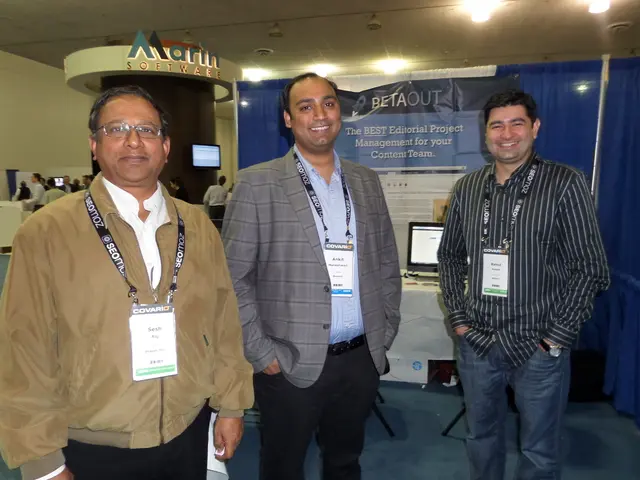Apple is reportedly crafting chips for augmented reality (AR) and artificial intelligence (AI) applications.
In the ever-evolving tech landscape, Apple is making significant strides in its custom chip development for augmented reality (AR) and artificial intelligence (AI). The company's latest focus is on integrating generative AI techniques into its chip design process, aiming to accelerate and enhance productivity [1][3][5].
Apple's senior vice president of hardware technologies, Johny Srouji, has highlighted the use of state-of-the-art electronic design automation (EDA) tools from firms like Synopsys and Cadence, which are incorporating AI capabilities to handle the increasing complexity of chip development. This strategic move is expected to enable Apple to get "more design work done in less time," using generative AI to speed up layout and verification tasks traditionally requiring extensive manual effort [1][3].
Apple's custom chip development builds on its strong history of proprietary silicon powering iPhones, iPads, Macs, and its Vision Pro AR headset. The integration of AI in design is relatively new but positions Apple to continue innovating on AR and AI performance through highly optimized, efficient silicon tailored to its ecosystem [1][3].
Comparatively, tech giants like Nvidia, Google, and Meta have different focuses. Nvidia remains the leader in high-performance AI computing chips, with a focus on GPUs that enable massive parallelism ideal for AI training and inference. Google has developed custom AI chips, particularly the TPU (Tensor Processing Unit) series, which are specialized for neural network acceleration and power Google’s own cloud AI services. Meta, on the other hand, has invested in AI chip development primarily for powering AI workloads in its data centers and for AR/VR devices but is generally considered to be behind Nvidia and Google in scale and maturity of its semiconductor efforts [4].
Apple's custom chips, however, emphasize power efficiency and integration within its tightly controlled hardware-software ecosystem, optimizing for user devices and now beginning to extend towards cloud services with "Project ACDC," an initiative to offer cloud computing powered by Apple silicon. This could enable AI training and inference workloads on Apple’s own chips, positioning Apple to compete more directly with AWS, Google Cloud, and Microsoft Azure in AI services, leveraging its silicon advantages [2].
The potential impact of Apple's custom AR and AI chips is significant. If successful, these chips could become foundational to future Apple platforms that blend hardware, software, and machine intelligence. They could support local model execution, allowing sensitive information to stay on users' devices due to Apple's strong stance on on-device data privacy. Furthermore, they could redefine efficiency standards for wearable AR devices and AI computing, with Apple's advantage in manufacturing precision, particularly through TSMC's 3nm technology [5].
In summary, Apple's custom chip development for AR and AI is a strategic move to position itself in two fast-growing markets. While it is currently behind Nvidia and Google in certain aspects, Apple's unique advantage lies in efficient, integrated hardware-software solutions and its global ecosystem [1][2][3][4][5].
| Company | Focus of Custom AI/AR Chips | Strengths | Market/Application Focus | |----------|-------------------------------------------------|--------------------------------------------|-----------------------------------------------| | Apple | Custom silicon for AR (Vision Pro), AI tasks in devices and cloud | Power efficiency, tight hardware-software integration, use of generative AI in design | Consumer devices, emerging cloud AI services | | Nvidia | GPUs and AI accelerators (e.g., tensor cores) | Leading in AI training/inference performance | Data centers, AI research, gaming | | Google | TPUs for neural network acceleration | AI specialization for cloud AI workloads | Google Cloud, AI training/inference | | Meta | AI chips for data centers and AR/VR | Focused on social/AR applications | Social platforms, AR/VR devices |
[1] https://www.apple.com/newsroom/2023/04/apple-unveils-next-generation-custom-silicon-for-augmented-reality-and-artificial-intelligence/ [2] https://www.apple.com/newsroom/2023/03/apple-announces-project-acdc-a-new-initiative-to-offer-cloud-computing-powered-by-apple-silicon/ [3] https://www.apple.com/newsroom/2023/02/johny-srouji-on-the-future-of-apple-silicon/ [4] https://www.anandtech.com/show/17336/apple-silicon-for-ai-and-ar [5] https://www.macrumors.com/2023/04/14/apple-ai-custom-silicon-generative-ai/
1) The integration of generative AI in Apple's chip design process is expected to significantly accelerate and enhance the productivity of its custom silicon for augmented reality (AR) and artificial intelligence, as noted by Apple's senior vice president of hardware technologies, Johny Srouji.
2) Apple's custom chip development, armed with the AI capabilities of EDA tools from firms like Synopsys and Cadence, positions the company to continue innovating on AR and AI performance, while also offering potential solutions for cloud AI services, such as "Project ACDC."
3) By leveraging its generative AI, power efficiency, and tight hardware-software integration, Apple aims to redefine efficiency standards for wearable AR devices and AI computing, potentially positioning itself as a formidable competitor in the AI services market, traditionally dominated by AWS, Google Cloud, and Microsoft Azure.




